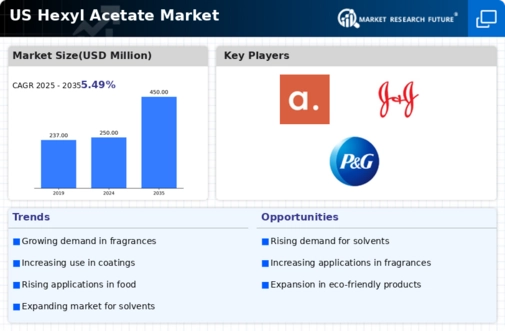The hexyl acetate market exhibits a dynamic competitive landscape characterized by a blend of innovation, strategic partnerships, and regional expansion. Key players such as BASF SE (Germany), Eastman Chemical Company (US), and Huntsman Corporation (US) are actively shaping the market through their distinct operational focuses. BASF SE (Germany) emphasizes sustainability and innovation, investing in eco-friendly production methods to enhance its product portfolio. Meanwhile, Eastman Chemical Company (US) is leveraging digital transformation to optimize its supply chain and improve operational efficiency. Huntsman Corporation (US) appears to be concentrating on strategic acquisitions to bolster its market presence, thereby intensifying competition among these major players.
The market structure is moderately fragmented, with several companies vying for market share. Key business tactics include localizing manufacturing to reduce costs and enhance supply chain resilience. This approach not only allows companies to respond swiftly to market demands but also mitigates risks associated with global supply chain disruptions. The collective influence of these key players fosters a competitive environment where innovation and operational efficiency are paramount.
In October 2025, BASF SE (Germany) announced the launch of a new line of bio-based hexyl acetate products aimed at reducing carbon emissions. This strategic move underscores the company's commitment to sustainability and positions it favorably in a market increasingly driven by environmental considerations. The introduction of these products is likely to attract environmentally conscious consumers and businesses, enhancing BASF's competitive edge.
In September 2025, Eastman Chemical Company (US) unveiled a digital platform designed to streamline its supply chain operations. This initiative is expected to improve transparency and efficiency, allowing the company to respond more effectively to customer needs. By integrating advanced analytics and AI into its operations, Eastman is not only enhancing its service offerings but also setting a benchmark for operational excellence in the industry.
In August 2025, Huntsman Corporation (US) completed the acquisition of a specialty chemicals firm, which is anticipated to expand its product offerings in the hexyl acetate segment. This acquisition aligns with Huntsman's strategy to diversify its portfolio and strengthen its market position. The integration of new technologies and expertise from the acquired firm could potentially lead to innovative product developments, further intensifying competition in the market.
As of November 2025, the competitive trends in the hexyl acetate market are increasingly defined by digitalization, sustainability, and the integration of AI technologies. Strategic alliances among key players are becoming more prevalent, facilitating knowledge sharing and resource optimization. Looking ahead, the competitive differentiation is likely to evolve from traditional price-based competition to a focus on innovation, technological advancements, and supply chain reliability. Companies that can effectively leverage these trends will likely secure a more robust market position.














Leave a Comment